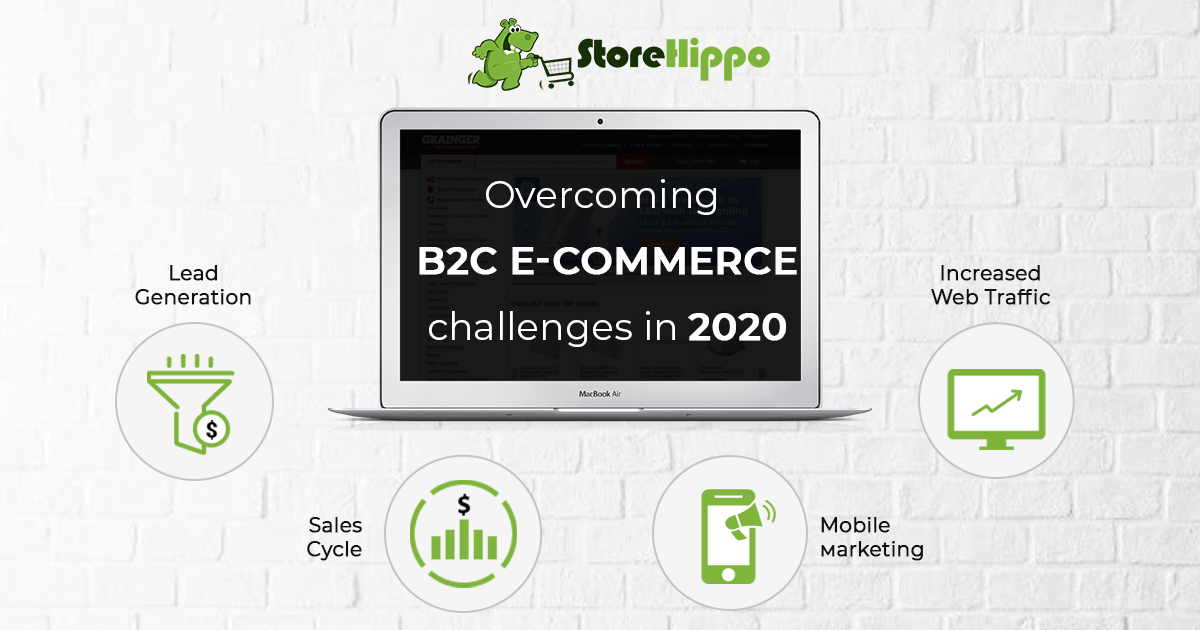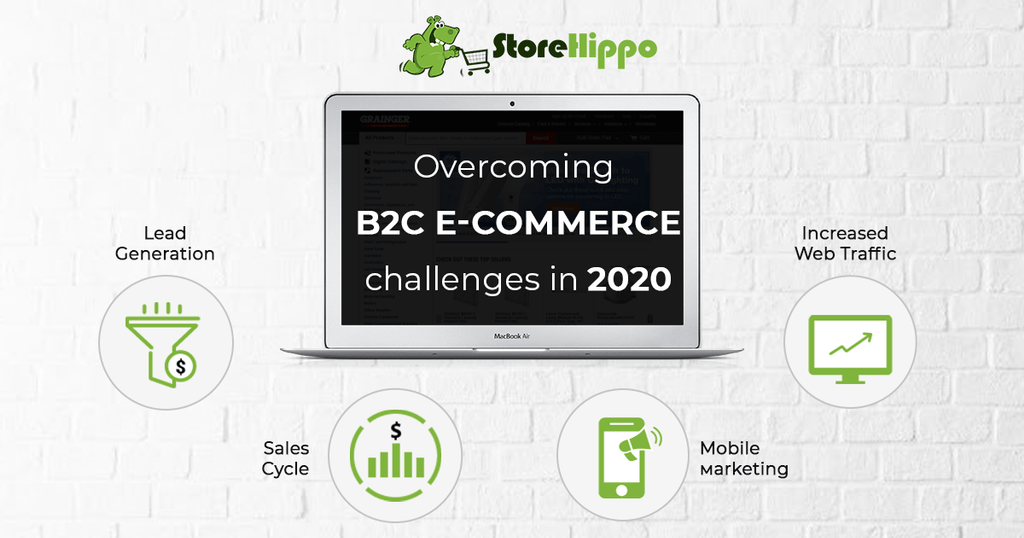Majority of people think of electronic commerce as a consumer-facing variety. And in some cases, it seems reasonable. Why? Because B2C ecommerce is mostly about catering to as many prospective customers as possible while relaying simple benefits in broad strokes.
Business to Business commerce, however, presents a very different set of challenges.
The best business experiences, if you look closely, are carefully honed to meet niche requirements. Their main focus remains on company-wide difficulties (typically for specific industries).
1. Generating more leads
Generating quality leads has and will always remain the biggest challenge for B2B marketers. You think simply capturing leads is enough, well think again. Because today, more than ever, sales and marketing teams need to work hand in hand so as to generate content that captivates users and makes them fill out landing page opt-in forms.
Marketers not only need to develop inspiring content but they also need to encourage business clients to take significant actions that will help fulfil your business goals.
Below are three such approaches you can use to generate more leads.
- Expanding your market- if you are aiming for the global wholesale marketplace, you must know how to develop content for international markets. This will ensure that your content can be accessed from anywhere in the world, which will lead to unlimited business opportunities.
- Developing contenting- you must know how to cover a wider range of prospects if you really wish to connect with a bigger target audience. For this, you will need to focus more on researching keywords that your customers might use while searching online. It will help you identify gaps in your ecommerce content strategy that you haven’t covered yet and create the fitting content.
- A/B Testing- when you start experimenting with your content narrative (including headline and featured images), you will not only gain data about what type of content gets the most clicks but also where people click or leave their content information. This experiment is important because the information you gain will help you learn what combo brings the most leads online.
2. Long sales cycle
You can not avoid the longer sales cycle if you work in the B2B industry. What you can do, however, is to make the sales process smoother. How? By following what the prospects do on your website in order to better assess at what stage of the sales cycle they currently reside.
And the best way to have full control over a long Business to Business sales cycle is to implement a CRM system. A CRM or Customer Relationship System can easily gather all the required information about your wholesale clients in one section. This information can be anything from the deals that you’ve signed to the emails you have exchanged to your notes and appointments, all in one place.
And the benefits, you asked? Well, they are pretty straightforward.
- Healthy pipeline- a well-placed CRM system helps you visualize your pipeline and focus on tasks (that can get you closer to the deal) accordingly. With its help, you can easily measure sales pipeline metrics and make sales report too.
- Improved relationships- the entire ecommerce journey from prospect to buyer can be completed on a CRM platform. As you acquire prospects, you can track their behaviour and score them accordingly. You can, later on, used the information to nurture leads and to prioritize outreach.
- Improved communication- a sturdy CRM system also assists you in communicating with every team member. It also means every bit of information and important resource is readily available to everyone involved in a particular project.
3. Increased competition
We understand the B2B industry is not a battlefield but we also understand that getting beaten by your competitors can give you the feeling of losing a battle. Failing to capture a target customer can be gruelling, even more so when you know what you have is better than what your competitors can offer.
At one point or another in the conversation with your potential client, you know you have failed to convince them that you are the better choice, despite your best intentions.
Below we have mentioned some such strategies that will give you the power to beat your competitors and help you generate more wholesale leads.
- Spot the competitors- the first step is to recognize the competition before beating it. Once identified, focus on how they operate such as what they offer, how they position themselves, their strong areas etc.
- Find the decision-making factors- these factors play a vital role when it comes to considering a particular product. And while finding them, do keep in mind that these companies are run by human beings (who come with their own specific priorities).
- Assess yourself- analyze yourself as an ecommerce business first. What are your strong traits and why are they better than your competitors. And in case your competitors are better than you, work hard and learn your craft better.
4. Measuring ROI
Another big Business to Business challenge wholesalers should plan for 2020 is the proof of Return of Investment or ROI. The Hubspot survey also claims that as much as 40% of business marketers agree that one of their main challenges is to prove the ROI of their efforts.
But, if we look closely, ROI is not something that can happen in a flash. That’s why we need accurate planning so as to make sure the ROI is traceable from the beginning of the efforts put towards B2B marketing and sales.
So, what can we do to measure and increase the return on investments?
Simple, focus on determining KPIs and goals. The idea here is to set goals you can measure. And the best place to begin is by measuring the performance of the content and website along with other marketing activities. Once you have accomplished this, you can move on to the other KPIs to help you out. These may include-
- The time spent on site pages
- Total number of site visits
- Client acquisition cost
- Number of new leads
- Ecommerce website bounce rate
- Client lifetime value
- Click-through rate
4. Positioning value proposition
Your value proposition always plays a pivotal role in the growth of your business. What is a value proposition, you ask? It is basically a strong summary of the main benefits that you offer to your target business client. It also defines the distinction between you and your competitors alongside the value that you give to your prospects.
Unfortunately. Not many businesses know how to define a distinctive value proposition. It is a combination of an entire set of traits and business elements (the ones mentioned below) presented to wholesale prospects and existing customers.
- First of all, you need to create products or services that justifies the perceived value. And to do that, you need to access beforehand what you deliver to your clients. Try to bring innovation to your product offer in order to make sure that you stay unique and relevant.
- Value i.e. what the customers get in return for what they pay. It is crucial to think about both the tangible and intangible benefits of your product. Thinking about every valuable aspect of your product is important if you want your B2B customers to pay premium prices for your products.
- Target market i.e. the people who buy your products or services. Unlike b2c, you simply cannot target everyone. You will need to segment your prospects by buying behaviours, demographics, attitudes etc.
- You will also need to find the benefits that are of utmost importance to your customers, and you will need to connect those benefits too. Here you can think of functions, product attributes or emotional benefits.
- Comparing your value proposition against your competitors is another important factor you need to consider. Think of the reasons why other ecommerce businesses should prefer your product instead of your competitors. In short, why are you better than your rivals.
- Should your customers take you for your words? We think not. Which is why you need to include proof in the form of case studies, testimonials, customer reviews etc. to convince them to buy from you.
With a well-structured value proposition at your disposal, you won’t face much difficulty selling products and serving your business clients.
5. Increased web traffic
With online competition increasing day by day, increasing web traffic won’t be an easy task, especially for wholesale businesses. The primary reason being, since Business to Business companies mostly market and sell to other companies, they don’t invest in inbound marketing which can help boost their web traffic.
These business companies often fall under the illusion that either their clients don’t buy online or if they do, the companies strategies won’t work on them (since they belong to a really narrow and exclusive niche). What these companies don’t understand is, if applied correctly, inbound marketing can become one of the most effective ways to grow a B2B company online.
- If only you knew the full potential of social media, you won’t have to worry about getting online traffic to your website. In the Business to Business industry, managers and CEO use LinkedIn in their free time. You should too. If you look at other social networks, they too have professional groups and pages dedicated to a niche topic. You should have one too. There you can find new leads to bring to your business website.
- Another best strategy you can use to generate more traffic is by creating content and publishing it. It doesn’t even matter what industry you belong to, you need to maintain a regular blog on your ecommerce website. Potential clients often do little research before finalizing a product. The idea here is to offer your prospects answers to their queries so they can make better choices for themselves.
- Lastly, you need to deal with the SEO aspect. Because you cannot hope to have a constant flow of web traffic without being on top of Google’s search results. The more relevant keywords you will use, the better optimized you will be for the search engines. Do this and you will be rewarded with a good Google ranking which in turn, will your web traffic.
6. Indecisive buyers
Imagine what a sales process would be if there weren’t any objections. Whenever a wholesale prospect comes up with certain objections, however trivial they may seem, it simply means something is not communicated properly.
In such a case, there are two possibilities, either the potential client is just making an excuse not to buy or he doesn’t see any real value in purchasing it.
Don’t worry, these things are pretty normal in Business to Business sales. It might have happened to you too, you reach a prospect with the budget and the need for the B2B product but when it comes down to making the final decision, they back out. At one point or another, we all have faced similar issues, and yes, it’s not an enjoyable situation at all.
This is the point where you need to focus all your energy on the one thing that people love to hear about the most- themselves.
So, whenever you feel like the potential client is indecisive, always listen carefully. Plus, you can ask them open-minded questions that will make them think more about their needs and problems.
Doing this will make the person on the other side feel better if the wholesale buyer knows that what he or she has to say is important to you.
You can access whatever they tell you and then ask follow-up questions so as to guide the conversation towards making a decision that benefits both parties.
7. Keeping pace with mobile marketing
Google claims that in 2020, the average mobile usage per business worker is expected to rise from 2hours/day to 3 hours/day (Source). This increase will be vital in your case if you are looking to keep up with the latest Business to Business ecommerce trends. This involves SEO too, and the marketing teams need to foresee the keywords that help the company to be found online.
Nowadays, mobile has become a crucial element not only to B2C but b2b marketing as well. Business clients use their mobile devices as an add-on to their laptops or desktops and expect an undifferentiated journey across all devices.
But to keep up with the latest mobile technology trends, you must optimize your business website’s mobile responsive design. This means that your B2B website should fit every screen size, be it smartphones, tablets, laptops or desktops. Keeping up with the latest mobile trends and staying up to date by offering your products, services and content on the go is the only way to beat this challenge.
Table of Contents
Closing In:
The Business to Business industry is constantly changing and convincing potential clients to work with you is no longer a simple task. In order to stay up to date with this ever-changing wholesale industry, it is important to be proactive in your marketing and sales strategy. Equally important is to find the channels where you can share relevant content because that is where the best leads reside. Plus your marketing and sales teams too need to work closely in order to bring more prospects into the sales funnel in 2020.
Overcoming these top Business to Business challenges means strengthening relationships with your buyers and gaining trust, and this our friends will be the key to ecommerce success in 2020 and beyond.
Check out StoreHippo B2B ecommerce solutions and prepare your business for success with the most comprehensive tools and features.





















Leave A Comment